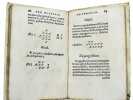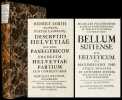4 books for « glareanus »Edit
-
Century
16th (1)
18th (1)
-
Topics
Astronomy (1)
Bleton auguste mr josse (1)
Engravings (1)
Helvética (1)
History (1)
Linnean society of lyons (1)
Lyons and area (1)
Lyons college (1)
Lyons college pc (1)
Lyons revue (1)
Medicine (1)
Part dieu (1)
Switzerland (1)
-
Countries
France (3)
Switzerland (1)
-
Syndicate
ILAB (3)
SLAM (2)
De Geography
Glareanus établit ici pour la première fois la déclinaison magnétique de l’aiguille du compas. Dans un second temps, l’auteur opère une description des continents dans laquelle la découverte de l’Amérique est mentionnée. Février, 1536. [Glarean]. Glaeranus, Henricus Loriti. De Geography liber unus, ab ipso authore iam tertio recognitus. Friburgum Brisgoiae, [Faber], 1536. In-4 de 35 ff.; complet; placé dans une reliure en peau de truie estampée sur ais de bois de l’époque, roulette à palmettes et médaillons floraux; commentaires manuscrits en marge rognés. 189 x 136 mm. Texte de référence important dans lequel Glareanus a jeté les bases de la géographie mathématique et a été le premier à déterminer la déclinaison dite magnétique. Réédition fribourgeoise ornée de 19 croquis et d’un tableau gravé sur bois de ce texte de géographie scientifique d’importance qui fut publié pour la première fois en 1527. Henricus Glareanus In: Encyclopedia Britannica; Harrisse, 142, pp. 262-263 (pour la première édition); Sabin n°27542. L’auteur, Glaréan (1488-1563), humaniste et universitaire rhénan installé à Bâle, y propose une réflexion de mathématiques appliquées à la géographie, dans laquelle il établit pour la première fois la déclinaison magnétique de l’aiguille du compas. Dans un second temps, l'auteur opère une description des continents dans laquelle la découverte de l'Amérique est mentionnée: "Porrò ad occidentem terra est, quam Americam vocant, longitudine octoginta fermè graduum. Duae insulae Spagnola & Isabella : quae quidem regiones secundum littora ab Hispanis lustrate sunt, Columbo Genuensi, & Amerigo Vesputio eius navigationis ducibus». Cet ouvrage d’autorité connut 19 éditions jusqu’au XVIIe siècle. « L’auteur était un homme d'un savoir prodigieux ; théologie, philosophie, géographie, histoire, chronologie, mathématiques, astronomie, toutes ces sciences étaient de son ressort, et il n'en est pas une seule sur laquelle il n'ait donné des ouvrages remarquables pour le temps où ils ont été composés. Érasme, son ami, fait l’éloge de Glareanus dans plusieurs de ses lettres, et loue ses mœurs et sa sobriété non moins que l'étendue de ses connaissances.» First treatise completely dedicated to the study of mathematical geography, previously published in 1527, by the illustrious Swiss humanist, mathematician, musician, philologist and poet laureate. Unlike the study manuals published until that moment, focusing on descriptive geography and chorography, Glareanus establishes with this text the foundations for a universal study of geographical disciplines, based on the principles of mathematics. The main difference compared to previous works - such as the Cosmographiae introductio by Matthias Ringmann (1482 - 1511), published in 1507 (Urbs Deodate [Vautrin & Nicolas Lud]) to accompany the famous world map (Universalis Cosmographia) by Martin Waldseemüller (1470 - 1521) and main source for the topics developed by Glarean in the De Geographia -, lies in the desire for an extensive use of mathematics in the study of geography aimed at taking it out of the particular and into the universal. This discipline was considered by Glareanus as in contrast with chorography, concerned with the qualities of a particular place, being in fact the former concerned with the quantities of a geometrical universe. The intent of Glareanus is purely didactic and responds to a formative need pretty heartfelt in the aftermath of the discovery of the New World. His manual had been conceived to be a valid and exhaustive text for those who would then have had to deal with geographic research, so, together with the elements of geometry and astronomy essential to the study of the sphaera (borrowed mainly from Euclid, Ptolemy and Sacrobosco), we find useful observations for the understanding of the terrestrial configuration, the different types of environments and the climate, up to the treatment of the centrality of two classical problems of modern geographic research: orientation (or the calculation of latitude and longitude, together with observations about the declination of the magnetic needle) and the difficulties related to the construction of reliable maps, the problem of cartographic projections, to solve which Glareanus relied on the gores method originally suggested by Waldseemüller for the construction of globes. This problem, however, will find a first, reliable solution, only with the conform projection of Gerardus Mercator (1512 - 1594) and the consequent birth of modern nautical charts, symbolized by his world map of 1569 (Nova et aucta Orbis Terrae Descriptio ad usum navigantium emendate accommodata). The book finishes with a long chapter dedicated to the description of the regions of the Earth, divided in Europa, Asia, Africa and De regionibus extram Ptolomaeum, where America is mentioned (leaf 35r). The success of the De Geographia was enormous, making of it a reference book for the study of geography for more than a century. It was reprinted 19 times between 1528 and 1681.
De vi arithmeticae practicae speciebus Henrici Glareani epitome.
Johannes Faber, Freiburg im Breisgau, 1539.
First edition. Heinrich Loriti (1488-1565), aka Glareanus, after the name of his native village Glaris, in Switzerland, was professor of mathematics and philosophy at Basel, then in College de France, in Paris. He later taught at Basel and Freiburg. His great friend Erasmus called him 'the champion of Swiss humanism'. He wrote on arithmetic, music and geometry. In this book, he first treats of notation, including the Greek, Roman, and Arabic systems; then of the elementary operations with integers; then, briefly, of progressions and proportion. Smith, Rara arithmetica, pp. 191-192. Tomash & Williams G49; USTC 631941. Hand note on 4 lines at the bottom of the title page, dated 1539 : "Hoc epitome G. Rorkenparhio C. à Wehingen ... " Signature "Lebegue", dated 1602. Some dampings here and their. Good copy. /// In-8 de 76, (2) pp., 1 f. bl. Vélin. (Reliure ancienne.) //// Première édition. Heinrich Loriti (1488-1565), alias Glareanus, du nom de son village natal Glaris, en Suisse, fut professeur de mathématiques et de philosophie à Bâle, puis au Collège de France, à Paris. Il a ensuite enseigné à Bâle et à Fribourg. Son grand ami Érasme l'appelait "le champion de l'humanisme suisse". Il a écrit sur l'arithmétique, la musique et la géométrie. Dans ce livre, il traite d'abord de la notation, y compris celle des systèmes grec, romain et arabe, puis des opérations élémentaires avec les nombres entiers et enfin, brièvement, des progressions et des proportions. Smith, Rara arithmetica, p. 191-192. Tomash & Williams G49 ; USTC 631941. Note manuscrite sur 4 lignes au bas de la page de titre, datée de 1539 : " Hoc epitome G. Rorkenparhio C. à Wehingen ... ". Signature "Lebégue, datée de 1602. Quelques mouillures ici et là. Bon exemplaire.
GLAREANUS (Henricus), Valla ( Lorenzo), Bade (Josse), Arhenanus ( Beatus Bild, dit)
Reference : 9766
(1555)
- Henrici Glareani In Titum Livium annotationes, cum chronologia ejusdem : cui Badii accessit elenchus. Ad haec Laur. Vallae de quibusdam apud Livium locis judicium.- In Titum Livium annotationes per Beatum Rhenanum & Sigismund Gelenium [et M. Antonium Sabellicum, Joannem Velcurionem, Joannem Saxonium]
1555 velin époque à recouvrement , restes de lies. 2 tomes en 1 vol. in-8, 375pp., 413pp. (mq. le dernier feuillet), Lyon Seb. Gryphe 1555,
Marque de Gryphe sur les titres.L'exemplaire de Lyon indique 2 pl. depl. qui manquent, qu'aurait celui de la Sorbonne mais il semble que cela s'applique à un supplément de 88ff .n.ch. ???
Phone number : 33 (0)6 77 77 12 33
Descriptio Helvetiae nec non panegyricon tredecim Helvetiae partium cum commentariis Oswaldi Myconii, Lucernani.
Zürich, Conrad Orelli und Comp., 1737. 8°. (2) Bl., 111 S. Pappband der Zeit mit Marmorpapierbezug.
Barth 17408 und 1108. – Haller V, 312. – Wyss 279. – Feller/Bonjour 125 und 261–262. – Herausgegeben von Johann Jacob Bodmer und Johann Jacob Breitinger. Angebunden: Pirckheimer, Willibald: Bellum suitense sive Helveticum cum Maximiliano Imp(eratore) atque dynastis et civitatibus suevicis feliciter gestum anno 1499. 4 Bl., 102 S. Zürich, C. Orelli und Comp. 1737. Wie oft zusammengebundene Separatausgaben von zwei lateinischen Quellenschriften zur Schweizergeschichte. Glareans erstmals im Dezember 1514 entstandene «Beschreibung der Schweiz. Lob der Dreizehn Orte» gilt als «ein Zentralwerk des schweizerischen Humanismus» (Feller/Bonjour). – Mit Exlibris von Paul Anton Wickart und handschr. Namenszug auf dem Vorsatz sowie einem Prägestempel.
 Write to the booksellers
Write to the booksellers






